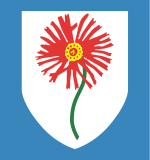Blue Bulls
They are governed by their second team the Vodacom Blue Bulls that participate in the ABSA Currie Cup and are based at Loftus Versfeld Stadium in Pretoria, Gauteng province.
Six members of the 1946 team later became Springboks: Hannes Brewis, Fonnie du Toit, Jorrie Jordaan, Flip Geel, Fiks van der Merwe, Louis Strydom and Daan Retief.
The wind was almost gale force and during this exciting struggle the two fly-halves, Thys van Zyl (Northern Tvl) and the later Springbok Keith Oxlee, kicked a lot.
[3] They were Willem Stapelberg, Alan Menter, Piet Uys, Mof Myburgh, Polla Fourie, Johan Spies, Frik du Preez and Thys Lourens.
This was the match in which South Africa's player of the century, Frik du Preez, dropped, scored and placed, according to his good friend and teammate, Springbok front ranker, Mof Myburgh.
The controversy which surrounded Transvaal's equalising points - a try by prop Theo Sauerman - once again emphasized the necessity of objective referees for Currie Cup finals.
Under the coaching of John Williams and captaincy of Naas Botha (returning at the end of 1984 after his stint in America) they defeated Transvaal in the final with a legendary performance by the captain, who scored all 24 points with 4 penalties and 4 drop goals.
On the Saturday they had to play Free State in the second semi-final and after trailing at one stage 11–0 in the first half and with about 20 minutes to go by 20–9, they managed to turn around the match and run out victors 27-23 - fullback (and old Grey College learner) Gerbrand Grobler being the hero with 6 penalties and a conversion!
Other players included Gavin Johnson, Rudolf Straeuli, Theo van Rensburg, Heinrich Rodgers, Johan Roux, Gerbrand Grobler and Hannes Strydom.
Northern Transvaal played four fixtures in the 1993 Super 10: The team had been known informally as the Blue Bulls since the 1940s and from 8 June 1963 in a newspaper cartoon by Victor Ivanoff had been portrayed as such.
But whatever Bulls captain Van der Westhuizen told his team while Gavin Lawless was setting up for the conversion of Joubert's second try, it made them realise that it was now or never.
And the last nail went into the Sharks coffin when the Bulls were awarded a penalty try for an early tackle by André Joubert on Grant Esterhuizen in the in-goal area.
With only a few minutes left on the clock, Province must have thought they won it when their Springbok-winger Chester Williams went over in the corner, but referee André Watson ruled the pass from Robbie Fleck forward.
As Kruger described it after the final: "The team's success could be ascribed to the fact that the Light Blue jersey made every player's heart beat faster."
They defeated the Golden Lions 31–7 at Ellis Park thanks mainly to heroics by a 19-year-old Derick Hougaard who scored a try, 2 drop goals and 5 penalties for a record 26 points.
Ettiene Botha received the ball just inside the Free State half and skipped and dummied his way past a legion of defenders - epitomising the great Mannetjies Roux against the Lions of 1962 - to score a brilliant try next to the posts.
The Blue Bulls shared the 2006 Currie Cup with the Free State Cheetahs with the score remaining locked at 28-all after twenty minutes of extra time.
The Blue Bulls have a positive winning record against all the South African domestic sides including their arch rivals, Western Province.
Many Blue Bull fans actually agree that the rivalry has shifted towards Free State, especially after both teams qualified for the Currie Cup final for the third consecutive year in 2006.
Brewis who was renowned for his speed and deadly drop goals, was a great playmaker that graced the Light Blue side when they won the Currie Cup in 1946.
In his playing career, he was regarded as probably the best fly-half in world rugby, and together with Fonnie du Toit, he formed the legendary halfback pair both at national and international level.
Tom van Vollenhoven the brush-cut wing who appeared on the scene in 1955, was the kind of player who captured the imagination every time he touched the ball.
Louis Schmidt played only two tests as Springbok flank, but for the Light Blues this man with the monster moustache, was a true hero who also made his mark as captain.
Despite being rather short for a lock, Du Preez's line-out work was practically unequalled and his powerful sprints struck fear in the hearts of his opposition, while he also kicked for posts for the Springboks and Northern Transvaal and put away some magnificent drop goals.
How popular he was, even outside Pretoria, is apparent from the fact that he was carried, shoulder high, off the field after his last game at Newlands in Cape Town in a match that Northerns won by 25–14.
The partnership he established with Brigadier Buurman van Zyl, was the foundation on which the Blue Bulls built their dominance of the Currie Cup scene in the 1970s.
It was also Oom Buurman who chose him as captain of the Blue Bulls in 1980 over many other more senior players like Daan du Plessis, Jan Oberholzster and Louis Moolman.
Thanks to his fiery performance and expertise he played many times for his province and country and was desperately unlucky to miss out on the 1995 World Cup year due to a neck injury.
The stadium was later renamed after Mr Robert Loftus Owen Versfeld, the founder of organised sports in Pretoria, and dedicated many years of his life to rugby union.
At the end of 1928, mainly as a result of the All Blacks tour, the Sub-union could show a record financial gain and used the profits to erect the changing-rooms and toilets they had waited for, for so long.
